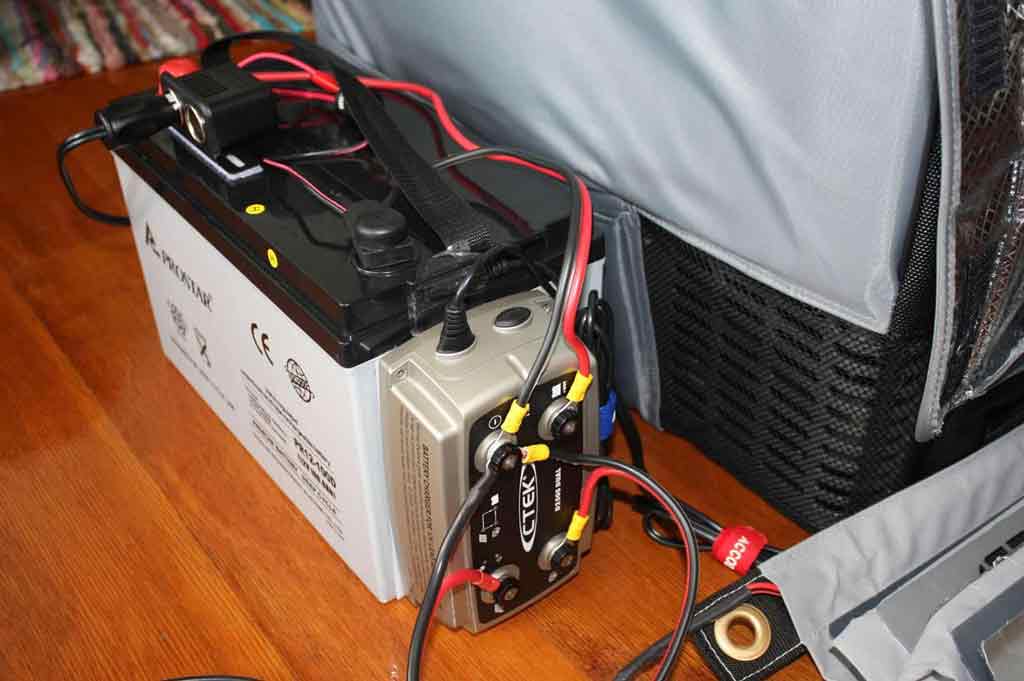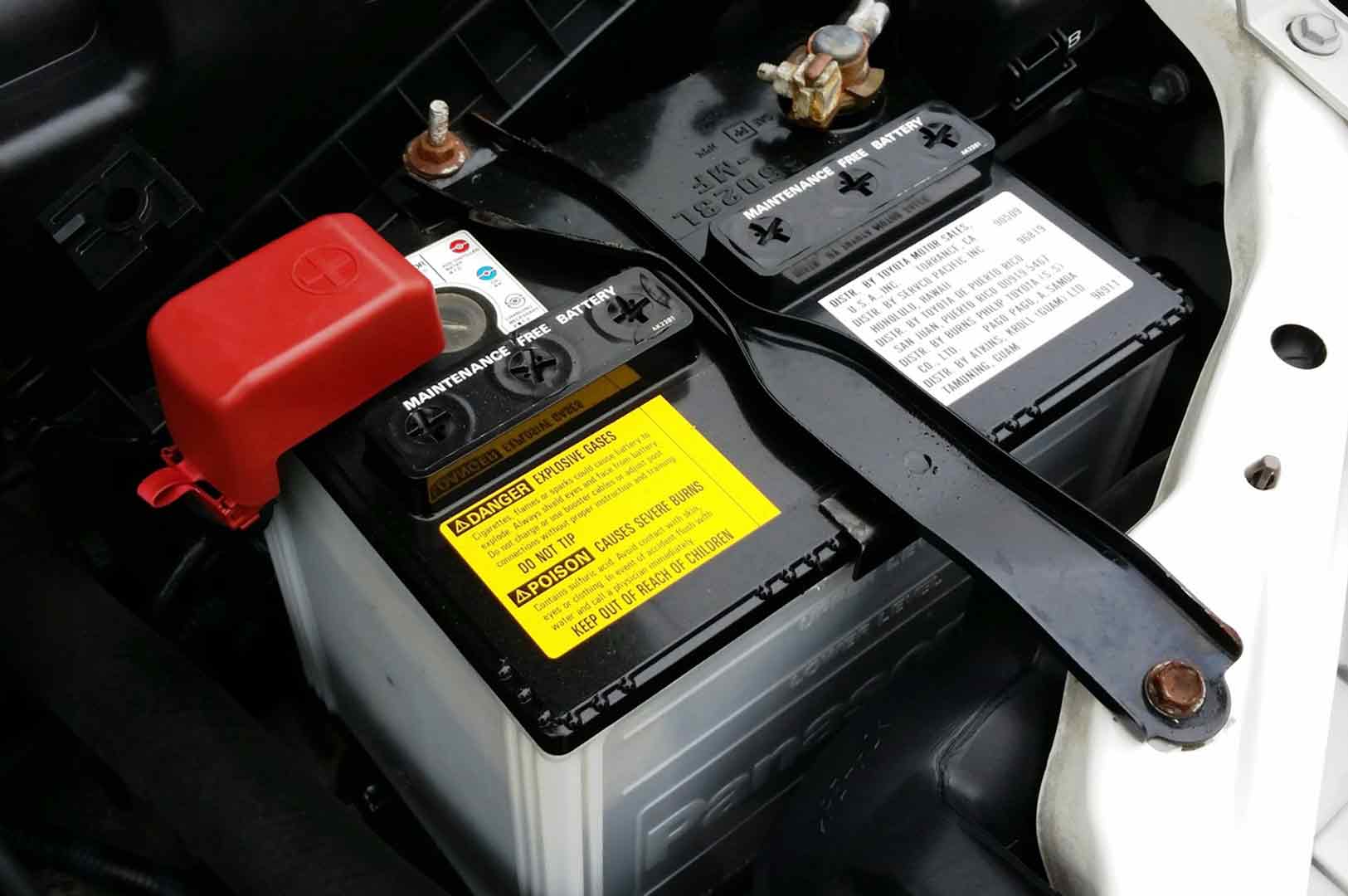Your desire requires a battery that can provide a steady current for long periods, even if it is flat. That is where the deep cycle battery comes to the rescue.
Compared to conventional batteries, deep cycle batteries offer quite a few benefits from longevity to maintenance which make them popular for RVing. Still, to get the most out of RV deep cycle batteries, RVers must pay special attention to a couple of things and charging is a prime example.
At a glance, the recharge of deep cycle batteries seems simple yet it only takes one mistake to ruin the cells. Let’s learn how to charge a deep cycle battery properly to keep your batteries always in tip-top condition.
Contents
Breaking Out In Details On The Deep Cycle Batteries
Before going into detailed deep cycle battery charging instructions, let’s dig deeper to understand this battery type base.
Deep cycle batteries are designed to provide a steady amount of power for long-time uses. These batteries can be charged and discharged many times without damaging or reducing their lifespan. Moreover, a deep cycle battery can revive even if the battery’s full power is exhausted. Overall, it is a perfect battery for unstable natural sources of energy.
Deep cycle batteries are optimized for deep discharge applications and are heavily cycled. Large deep cycle batteries with a capacity of 100-200 Ah or more can even be used as dual-purpose batteries and in diesel engines. However, this type of battery is not very suitable for such applications.
In general, deep cycle batteries vary in the mentioned aspects that we would like to show you below.
Size and Capacity
Small deep-cycle batteries appear in Uninterruptible Supply Systems (UPS), medical and security equipment. They are commonly used as, for example, trawler batteries. For large deep cycle batteries, people use these batteries them mostly in off-grid camping and applications, such as solar cells, backup batteries for critical activities, and RV batteries.
Chemistry
Deep cycle batteries in the market are mainly lead-acid batteries and lithium batteries.
Lead-acid batteries are wet/flooded, enhanced wet/flooded, advanced AGM (absorbent glass mat), and gel batteries.
The 12 volts is the supposed voltage of each lead-acid battery type. However, the actual voltage of charging in practical cases may be different.
Lithium batteries range considerably in chemistry, but the most common is the Lithium Iron Phosphate (LiFePO4) which is also the safest chemistry.
The start-up and deep cycle Lithium Iron Phosphate batteries come with a built-in Battery Management System (BMS) to raise the safety level further. This managing system protects the battery from unpredictable circumstances such as overcharges, overheated, over-discharge, and short circuits.
Voltage
Deep cycle batteries are mainly 12V but are also available at 6V, 24V, and 36V. Of course, these are just ‘nominal’ numbers. The actual battery voltages usually range from 10 volts or even less to nearly 15 volts.
Here is something to notice about the charging voltage. When lead-acid batteries are up to 15 volts or even more, they will release oxygen and hydrogen. Such a battery can significantly shorten its life and create unexpected dangerous situations as hydrogen is a highly flammable gas.
In addition, the charged deep cycle battery’s end voltage depends on its temperature. Every type of lead-acid battery has a temperature figure used to evaluate the optimal end-of-charge voltage.
The BMS system usually defines the end-charging voltage of a lithium battery automatically. When the battery reaches its charge-end voltage, the BMS will disconnect it from the charger to prevent the overcharged situation.
On the other hand, a good charger will not charge a lithium battery to its cutoff voltage. If the opposite issue occurs repeatedly, there is probably a problem arising within the deep cycle battery and its charger.
How To Charge A Deep Cycle Battery Properly?
Ways to charge a deep cycle battery are diverse though the battery shapes differently. However, there are only a few acts we recommend you use to get the best out of your battery. Suggested ways we – Effortless RVing will present now are charging with a smart charger, a typical charger, charging with a car alternator, and some other less-popular approaches.
Before getting things in line, understanding how a deep-cycle battery works and its expected long life within the desired range are all vital. With enough necessary knowledge, you can then ensure the smooth operation of components and your car on every trip in the future.
Using a deep cycle battery charger
First, we will show you the most basic way and steps to charge a deep cycle battery with a dedicated suitable charger. You will need to prepare several simple tools found in an everyday toolbox and local auto mechanic equipment stores.
Step 1.
Disconnect the deep cycle battery if necessary. If you have a stored battery that is most likely not connected to anything, then it’s all cool. Remove dirt, grease, or any dirty elements on top of your battery. Move your needy battery to a clean and dry place with good ventilation. It is ideal to be outdoor.
Step 2.
Remove the cover of the battery cells using a flat head screwdriver. With this initial cleaning act, you can throughout check the electrolyte level of each cell.
Even if your battery is sealed, you can easily remove the covers, which appear in caps on top of individual cells, or a big one covering all cells. To avoid any acid inside splashing out in the process, make sure to arm yourself with well-made eye protection such as glasses, goggles, face shields, and rubber gloves when removing the covers.
Step 3.
Place the hydrometer tip into a cell and draw liquid into the hydrometer. Follow the instructions to read the hydrometer. Some hydrometers use a floating ball to indicate if the cell is at a low level. And some will have a measuring needle.
You will need a proper liquid level to sustain the electrolytes within the deep cycle battery and assure that it will function well later. You can then add the distilled water to the battery. And after checking all cells, set the covers in their places.

Step 4
Determine whether you are charging 6, 12, or 24-volt deep cycle batteries. And arrange your charger to slow speed. If there is an option, set the voltage to 20 percent of the ah of the battery. You will see this amp hour rate on the top or side of your car battery.
Step 5
Take the charger’s cable and connect it to the terminals on the deep cycle battery. With both pieces of equipment, remember to link the positive to the positive, usually shown in form of a plus sign or a wire in red. Implement the exact process once again with the negative cable.
Step 6
Use the charge meter to check on your charger after 20 minutes of charging. For the charger to accurately read the actual charge level in the battery, it may take you a considerable long time.
If there is a voltage regulator integrated into your charger, you don’t have to keep an eye on the battery and can come back to it later. Conveniently, the deep cycle battery charger will shut down by itself when your battery reaches the proper voltage. If your use a typical charger without a regulator, you should check the charge meter hourly until the battery is fully charged.
Once again, we need to remind each other about how to charge a deep cycle battery daily to assure that everyone can get the proper process. You should also note that a good and modern battery charger will always automatically switch to maintenance mode when the battery is full. It will do so while keeping the battery charged indefinitely without fear of the battery being too stressed.
Check your battery manual and learn about the ideal maximum charge current and terminal voltage for each type. These acts can help you protect and preserve your battery for longer and save you tons of time, effort, and money.
In short, charging with a smart lead-acid battery charger is the best way to charge a deep cycle battery in its stage of urging for help.
However, in many practical situations where flexibility and quick improvisation are required, deep cycle batteries can also be recharged using some of the other devices below. While they are not ‘ideal’ and give you a peace of mind feeling, they can be helpful in a few rare cases.
Using a solar charge controller
The power generated by solar panels is controlled by an MPPT or PWM solar charge controller, which can charge the battery as efficiently as possible.
The device’s charging current depends on lighting conditions, the number of solar panels, the size of the deep cycle battery, its chemistry, and discharge rate.
Charging a deep cycle battery using a solar charge controller is one of the most preferred methods among campers, hikers, fishers, and individuals who live off the grid.
Using a power generator
We can charge an RV battery using an RV generator. The power generators can transform fuel energy into electrical energy.
As a 12V deep cycle lead-acid battery with 8-10 amps can be charged by some small generators with the identical figure, you can sometimes rely on this method to quickly fill your battery power without a proper smart device.
To power the bigger-size deep cycle batteries of each type, you can use a car generator with its 120V or 240V output and connect it to a smart battery charger.
With this method, you can rest assured that your deep cycle batteries will be full-filled again and leave you no worry when enjoying your time at the campsite or in unexpected urgent cases.
Though it is suitable for urgency, some problems can arise in the mid-process when using a car alternator without initial understanding.
First, the charging will have absolutely no charging current control. Line voltage may not be an issue with small and mid-size deep cycle batteries. However, the bigger ones can drain a considerable amount of current and make the voltage goes below limits. This act will result in an auto-shutdown situation, or the generator will immediately stop working. Or even worse, your car may be on fire in just seconds, literally.
Remember to recharge a deep cycle battery in only 5-10 minutes with an alternator on a typical car. Check the car’s handbook if possible, or at the very least, keep an eye on the temperature of the alternator.
If you choose to recharge the deep cycle or any other type of battery with a car alternator, you are solely responsible for the results. It’s a good idea to prepare yourself for the worst scenarios, including the burning flames. No one can foresee anything when using such a difficult-to-control charging method and a power source.
Using a cigarette lighter adapter
Another less common but possible way to clear up the difficulties in your deep cycle battery charging wonderings is using a car cigarette lighter adapter.
The 10-amps-circuit car cigarette lighter adapters can charge your full-of-weakness battery at ease. But you will not be the one who controls the desired charging current when the battery is directly attached to the source.
When using the cigarette lighter adapter to power the battery or car inverters, we recommend you should start the engine first.
Note that some automobiles equipped with cigarette lighter adapters have a restricted time of operation, specifically when forced to the limit. They will automatically shut off if they become overheated. So beware.
Wrapping Up
We have just gone through some worthy notices on how to charge a deep cycle battery using possible methods that are commended by many sources. However, it is best to charge your battery with a specified charger to keep its life the longest.
We hope you find our piece of information helpful. See you next time with more updated car maintenance tips.
